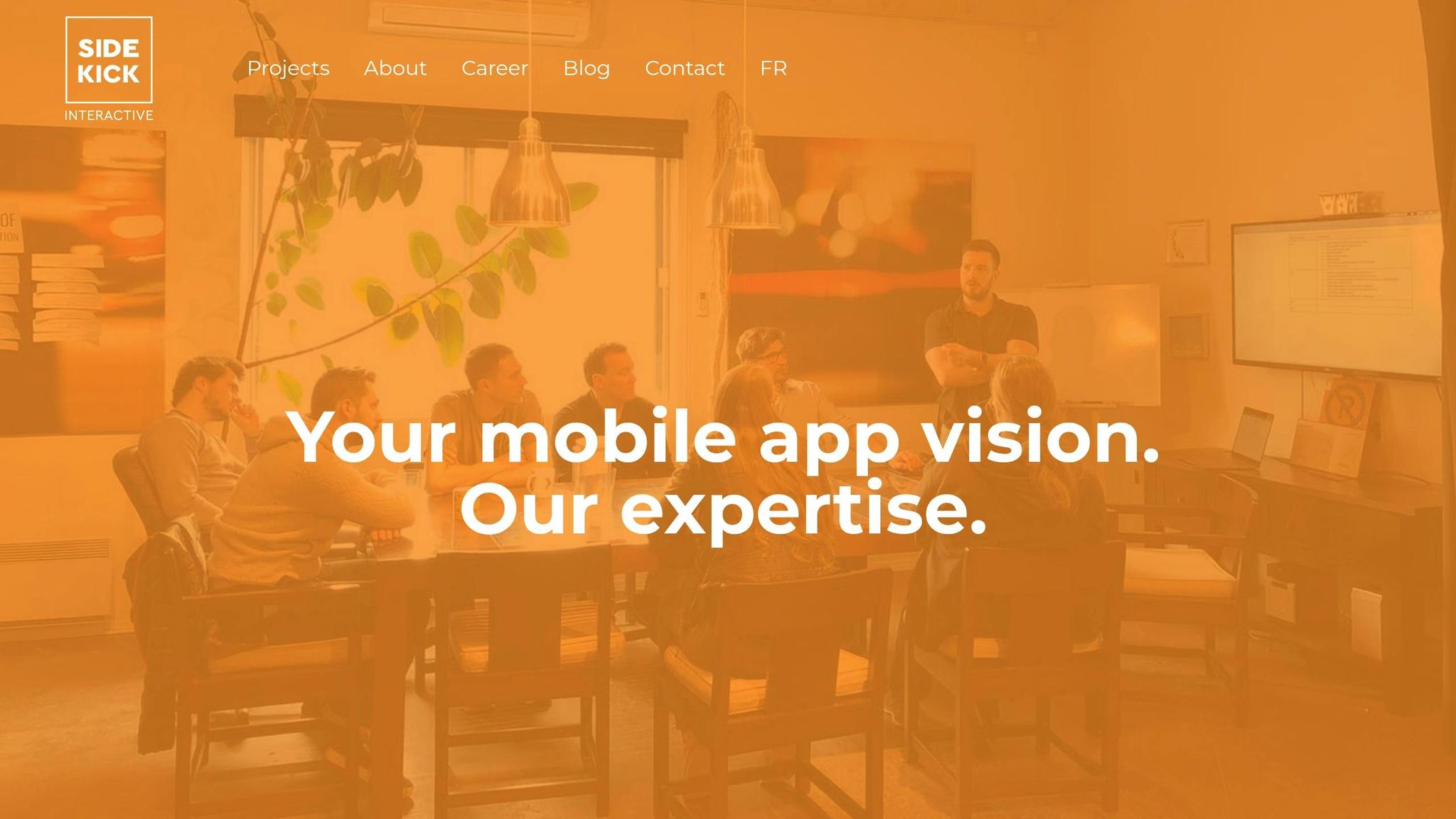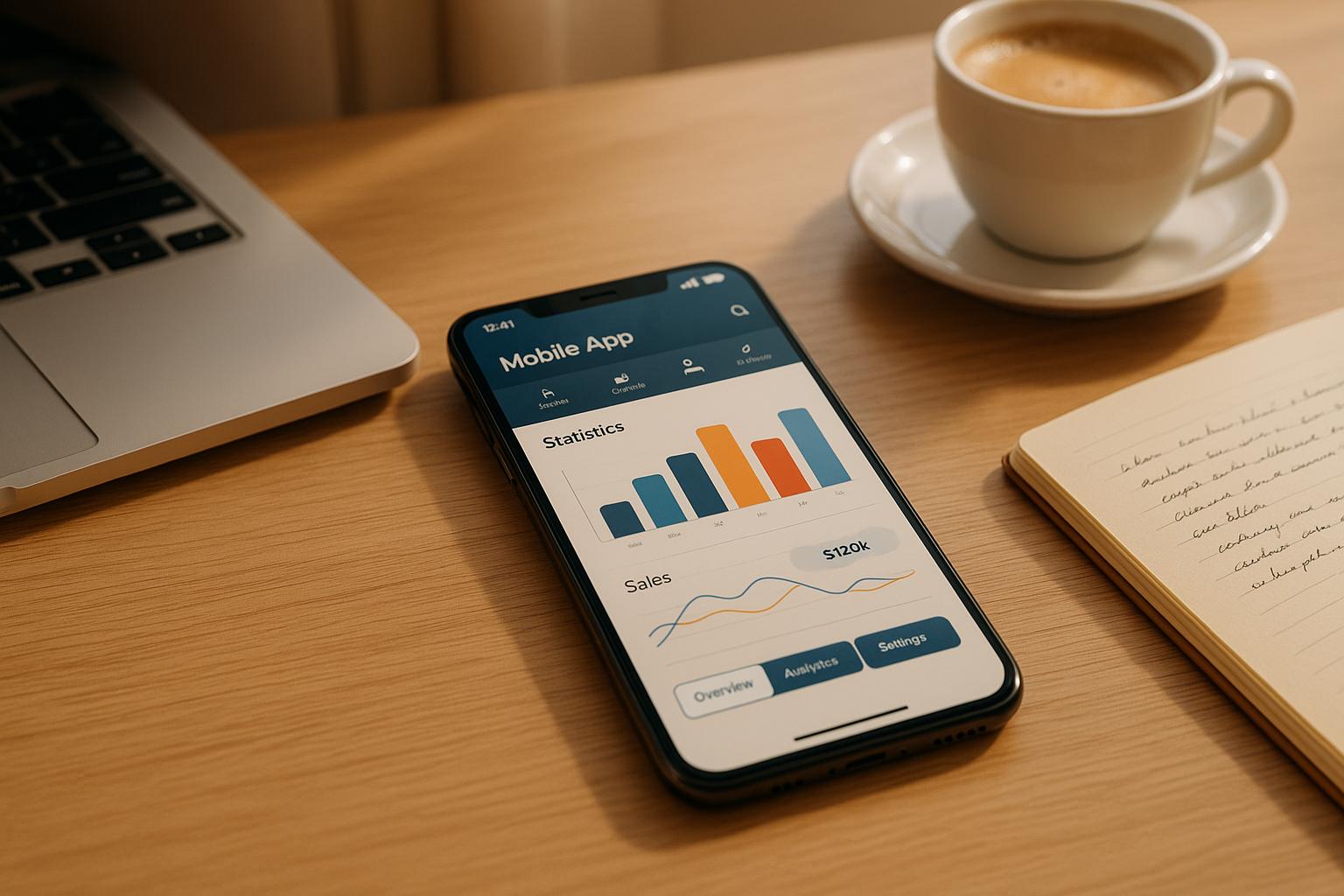How much does it cost to develop a mobile app in Canada? It can range from $10,000 to over $100,000 depending on factors like app complexity, platform choice, and advanced features. Here’s a quick breakdown:
- Basic apps: $10,000–$30,000 (e.g., user login, simple database).
- Intermediate apps: $30,000–$70,000 (e.g., GPS, push notifications).
- Complex apps: $70,000–$100,000+ (e.g., multiple integrations, custom features).
To save costs:
- Start with an MVP (Minimum Viable Product) to focus on core features.
- Use cross-platform development to reduce expenses by 50–75% compared to native apps.
- Budget for post-launch maintenance (20–50% of initial costs).
Pro tip: Plan carefully, prioritize essential features, and choose the right platform (iOS, Android, or both) to align with your budget. For healthcare, finance, or IoT apps, expect higher costs due to specialized requirements like security and compliance.
How Much Does It REALLY Cost to Build an App in 2025 …
Main Cost Factors in App Development
Several elements influence the cost of developing an app. These factors play a crucial role in shaping your budget, covering both the initial investment and ongoing expenses. Let’s break down how app size, platform choice, and advanced features impact costs.
App Size and Features
The scope and complexity of an app are major cost drivers. Basic apps with limited functionality typically start at around $10,000, while more complex solutions can exceed $100,000. Here’s a breakdown of how feature sets influence pricing:
| App Complexity | Features Included | Estimated Cost Range |
|---|---|---|
| Basic | User login, simple database, basic interface | $10,000 – $30,000 |
| Intermediate | API connections, GPS, push notifications | $30,000 – $70,000 |
| Complex | Multiple integrations, custom features | $70,000 – $100,000+ |
"The expense of building a versatile application will fluctuate because of the application’s elements, complexity and the kind of mobile app development company that is going to develop it." – Hyperlink InfoSystem
If you’re looking to manage costs, start with essential features. Adding advanced functionalities like GPS or multiple API integrations can significantly increase both development time and expenses.
Platform choice is another critical factor that can shape your budget.
iOS vs Android Development Costs
Developing native apps for both iOS and Android can double your costs since it requires separate teams and codebases. Opting for cross-platform development can reduce expenses, costing about 50–75% of what you’d spend on native solutions.
Advanced Tech Integration Costs
Features like API connections, push notifications, and Bluetooth require specialized skills, which can extend development timelines and increase maintenance costs. These elements are particularly important for IoT-focused apps.
To avoid overspending, define your requirements clearly from the start. Gathering user feedback before committing to advanced features can ensure you’re allocating resources to functionalities that genuinely matter to your audience.
Development Phase Cost Guide
Understanding how costs are distributed across the various stages of development is crucial for effective budget planning. Here’s a breakdown of the primary phases and their associated expenses.
Research and Design Costs
The research and design phase sets the groundwork for your app. In Canada, market research and analysis typically cost between $40–$80 per hour, while UI/UX design services range from $60–$100 per hour.
| Development Stage | Timeline | Cost Range |
|---|---|---|
| Market Research & Analysis | 2–4 weeks | $3,000–$10,000 |
| UI/UX Design | 4–8 weeks | $5,000–$20,000 |
This phase involves market analysis, user flow mapping, and creating responsive mockups. These steps help minimize costly changes later in the process.
Once the design is finalized, the development phase begins in full swing.
Core Development Costs
The core development stage represents the largest portion of your budget. This phase includes both frontend and backend development, and the costs vary depending on the complexity of the app:
- Basic apps require 500–600 hours.
- Medium-complexity apps need 900–1,000 hours.
- Complex apps take over 1,000 hours.
The development approach you choose also plays a major role in determining costs:
- Native development: $200,000–$300,000
- Cross-platform solutions: Around $100,000
- Hybrid development: Approximately $50,000
Testing and Launch Costs
Testing ensures your app performs smoothly across devices. Senior developers, who typically handle testing, charge an average of $100 per hour, which can help streamline the process.
To manage costs effectively, focus on user experience research and break down complex features into smaller, more manageable milestones. This approach not only helps control expenses but also ensures your app is delivered with top-notch quality.
sbb-itb-7af2948
Industry-Specific Development Costs
Project features and complexity often determine development costs, but industry-specific requirements can significantly impact these estimates. Below is a breakdown of how costs vary across different industries.
Medical App Costs
Healthcare apps need to comply with strict security and regulatory standards, which can increase costs by 15–30%. Even basic medical apps must meet these requirements, with development costs typically falling between $75,000 and $90,000. For more advanced solutions, costs often exceed $90,000.
Banking App Costs
Financial apps require advanced security measures and complex integrations to ensure secure and efficient transactions. Smaller banking applications generally cost between $20,000 and $50,000, depending on their scale and features. For enterprise-level banking apps, which must meet rigorous security standards and handle complex integrations, costs usually start at $90,000.
IoT App Development Costs
Developing IoT apps involves specialized skills to enable device connectivity and manage data synchronization. Costs depend on factors like the number of connected devices, real-time monitoring needs, and features such as GPS tracking, push notifications, and Bluetooth connectivity. Development costs range from $37,912 to $171,450 at an hourly rate of $150. For highly complex enterprise IoT solutions, costs can climb to $727,500.
Cost Reduction Methods
Understanding what drives costs can help you create strategies to lower expenses effectively.
MVP Development Benefits
Starting with a Minimum Viable Product (MVP) is a smart way to manage development costs. It’s particularly important because 42% of apps fail due to a lack of market demand. An MVP helps validate your idea while keeping initial costs lower – ranging from about $13,000 with freelancers to $35,000 when outsourcing.
Here’s why an MVP can be a game-changer:
- Confirms whether there’s market demand
- Helps conserve financial resources
- Provides valuable user feedback early on
- Reduces both development time and costs
Platform Selection Guide
Choosing the right platform can significantly impact your budget. Cross-platform frameworks, like React Native, can reduce costs by up to 50% compared to native development and shorten development time by about 30%.
| Aspect | Cost Impact | Time-to-Market | Annual Maintenance |
|---|---|---|---|
| Native Development | $80,000–$160,000 | 6–12 months | 35–50% of initial costs |
| Cross-Platform | $50,000–$100,000 | 4–6 months | 20–30% of initial costs |
"The technology stack you choose serves as your application’s foundation – determining its functionality, scalability, maintenance requirements, and overall user experience." – DEV Community
Working with Sidekick Interactive

Using these cost-saving strategies, partnering with Sidekick Interactive can further streamline development and reduce expenses. Their specialized teams offer:
- Proven Security Frameworks: Especially important for industries like healthcare and finance
- Technical Expertise: Efficient workflows to optimize development
- Industry-Specific Knowledge: Helps avoid expensive revisions by addressing sector-specific needs
For projects requiring advanced features like 3D scanning or augmented reality, their experienced developers ensure smooth implementation. This is particularly critical when working with sensitive data or transitioning from low-code platforms to more secure applications.
Conclusion: Planning Your App Budget
Plan your mobile app budget by aligning your project needs with the realities of the market.
A solid budget typically spans three main phases:
| Development Phase | Budget Allocation | Key Focus Areas |
|---|---|---|
| Initial Planning | 15-20% | Requirements analysis, platform choice |
| Core Development | 50-60% | Building features, technical architecture |
| Testing & Launch | 20-25% | Quality checks, deployment, early support |
This breakdown offers a clear roadmap for allocating resources throughout the project.
"The expense of building a versatile application will fluctuate because of the application’s elements, complexity and the kind of mobile app development company that is going to develop it"
To manage your budget wisely:
- Clarify essential requirements before starting development.
- Focus on one platform (iOS or Android) initially to save costs.
- Prioritize key features that deliver the most value early on.
- Set aside funds for updates and maintenance after launch.
This approach helps you stay on track and avoid unnecessary expenses.
FAQs
How do I choose between native and cross-platform app development for my business?
Choosing between native and cross-platform app development depends on your project’s specific needs and priorities.
Native apps are designed for a single platform, like iOS or Android, and are built using platform-specific programming languages. They deliver superior performance, seamless integration with device features, and a polished user experience. However, native development often involves higher costs and longer timelines since separate codebases are required for each platform.
Cross-platform apps, built with frameworks like React Native or Flutter, allow you to create a single codebase that works on multiple platforms. This approach can save time and reduce development costs while still offering a consistent user experience. React Native is ideal for projects needing a balance of speed and performance, while Flutter is better suited for apps requiring advanced customizations.
If performance and platform-specific features are your top priorities, go with native development. For faster delivery and broader reach, cross-platform development is a more efficient choice.
What should I watch out for when budgeting for app maintenance and updates after launch?
When planning your post-launch budget, it’s important to account for all ongoing costs to avoid surprises. Common pitfalls include underestimating hosting fees, which can range from $70 to $320 per month depending on your app’s complexity, and neglecting the costs of adding new features, which vary based on scope and developer rates (averaging $41–$54 per hour in the U.S.).
Don’t forget about customer support expenses, which depend on staffing needs and typically range from $15 to $19 per hour, as well as app store fees like Apple’s $99 annual fee or Google’s one-time $25 fee. Additionally, app stores often take a 30% cut of in-app purchases. Planning for these costs upfront will ensure your app remains functional, competitive, and aligned with user expectations.
How do specialized requirements in industries like healthcare or finance affect the cost and process of developing a mobile app?
Specialized industry requirements, such as those in healthcare or finance, can have a major impact on both the cost and development process of a mobile app. These sectors often demand strict security protocols, compliance with regulations like HIPAA (for healthcare) or PCI DSS (for finance), and advanced data management capabilities. Meeting these standards requires additional development time, rigorous testing, and expert knowledge, all of which can increase costs.
For example, incorporating advanced features like secure payment gateways, encrypted data storage, or real-time monitoring systems can significantly raise development expenses. Enterprise-level apps in these industries typically start around $90,000 and can go much higher depending on complexity. To manage costs effectively, it’s crucial to prioritize features that align with your business goals while ensuring compliance with industry standards.

